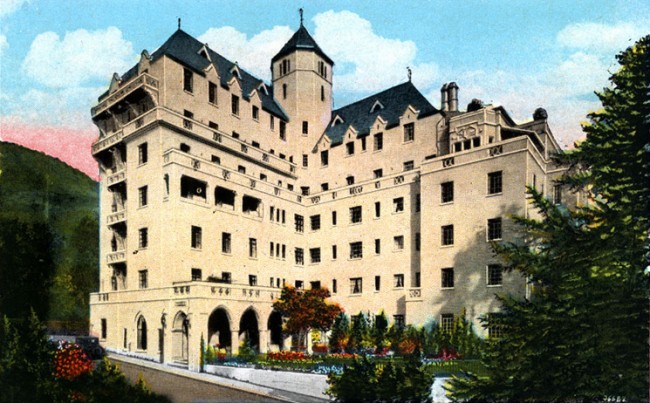
Archive
The History of West Hollywood and the Sunset Strip
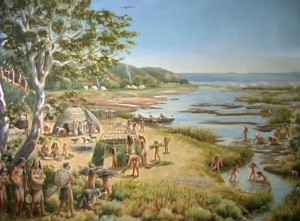 In 1542, the Portuguese explorer Juan Rodríguez Cabrillo became the first European to sail offshore where the modern city of San Pedro is located today. A few thousand Native Americans came out in canoes to meet the Explorer. They were members of the Tongva tribe of Native Americans who populated the area now known as the greater Los Angeles area. Their villages scattered from the dramatic shores of the Pacific, to the base of the Santa Monica Mountains. Of the 31 known village sites of the Tongva scattered around the Los Angeles basin, there was a large village of Tongva natives in the area we know today as West Hollywood. The village was estimated to have had and impressive 400 and 500 huts. The tribes of the Tongva were cooperative and wars, theft and attacks were few. It’s also interesting to note they believed in a single Supreme Being, the world was supported on the shoulders of 7 giants, and that the concept of the devil or of evil spirits, were unknown to them. They were, by all accounts, a peace-loving and brave people.
In 1542, the Portuguese explorer Juan Rodríguez Cabrillo became the first European to sail offshore where the modern city of San Pedro is located today. A few thousand Native Americans came out in canoes to meet the Explorer. They were members of the Tongva tribe of Native Americans who populated the area now known as the greater Los Angeles area. Their villages scattered from the dramatic shores of the Pacific, to the base of the Santa Monica Mountains. Of the 31 known village sites of the Tongva scattered around the Los Angeles basin, there was a large village of Tongva natives in the area we know today as West Hollywood. The village was estimated to have had and impressive 400 and 500 huts. The tribes of the Tongva were cooperative and wars, theft and attacks were few. It’s also interesting to note they believed in a single Supreme Being, the world was supported on the shoulders of 7 giants, and that the concept of the devil or of evil spirits, were unknown to them. They were, by all accounts, a peace-loving and brave people.
The missionaries arrived and by 1770, the friendly native Tongva were almost completely wiped out by diseases brought by the Europeans. Their land was confiscated and those who still remained were converted to Christianity. Their tribal name was changed to “Gabriellino” in reference to Mission San Gabriel, which was now the center of one of their last remaining villages
By 1780, great ranches began to take hold and into the mid-19th Century, ranches were spread from the village of Los Angeles westward to the ocean near modern day Santa Monica. These wealthy land barons were powerful and controlled much of the region. One of the largest ranches was “Rancho La Brea” and when California became a state in 1850, this same ranch would come under the control of the wealthy Hancock Family. A gentleman named Moses Hazeltine Sherman (1853-1932), a land developer, bought unincorporated land near the Hancock ranch where he founded a town called “Sherman”. The town flourished and became a whistle stop on the train and the town became a site of lumberyards and a center for light industry.
In 1910, Hollywood was incorporated into the city of Los Angeles because it needed the water supply, but not Sherman, which remained unincorporated and prosperous due to it’s important role as service industry supplier for the budding film industry and studios in nearby Hollywood. Sherman’s Sunset Boulevard was high against the Santa Monica Mountains and out of range for city police departments and federal agents, so it was natural that it became a center for gambling parlors and saloons. Sherman would later purchase land in the San Fernando Valley and the town of Sherman Oaks is named for him today.
When prohibition was implemented in 1920, the Sunset Strip was home to openly operated speakeasies and elegant nightclubs. It became a playground for early film stars like Charlie Chaplin, Mary Pickford, Rudolf Valentino, Billie Burke, Francis X. Bushman, and Douglas Fairbanks Sr., who were either residents or frequent visitors to the now infamous “Sunset Strip”. Impressive residential buildings, such as the “the Garden of Allah” (1927), “Chateau Marmont” (1927), and “Sunset Tower” (1929) evolved.
West Hollywood flourished during the 1930s and 1940s. Luxurious and elaborate nightclubs, such as “The Trocadero”, “Macambo” and “Ciros” became legend. It also evolved as an elegant shopping district.
After the war, the gay community “came out” and found solidarity in the Hollywood area, but with continued raids on their bars, they too moved to the neighborhood west of Hollywood, just outside the city limits of Los Angeles, where they were left alone.
As time moved on, the predominantly renting, Jewish, gay, and senior citizen residents of the progressive-minded area determined to step out of the shadows of nearby communities and create a city of their own, an effort that caused some controversy but resulted in the incorporation of West Hollywood in 1984. Since incorporation West Hollywood has been a beacon of hope, drawing refugees from Russia and around the world to its tolerant streets.
The Sunset Strip starts at Doheny Drive and ends a Crescent Heights Boulevard. Most know it as the area where famous rock clubs, hotels, restaurants, infamous nightclubs abound in Los Angeles. What most don’t know is how much rich history that this stretch of road in West Hollywood contains. It flourished as a place to gamble, drink and enjoy bawdy entertainment back in the early 20th century because it’s boundaries fell outside the city and it’s strict laws.
The recent Virgin Megastore was actually located on the same property where the legendary Schwab’s Pharmacy once stood. During the early 1930s, silent film stars Charlie Chaplin and Harold Lloyd would play the pinball machine games there. By 1937, it was so famous with Hollywood celebrities, the MGM publicity department made up a story that their newest star, Lana Turner, was discovered while sipping a malt there. Miss Turner actually skipped her Hollywood High School class one day and was discovered nearby at the “Top Hat Cafe” in Hollywood near the school instead. In 1938, Harold Arlin wrote the legendary song “Over the Rainbow” for film “The Wizard of Oz” at Schwab’s infamous soda fountain. A couple of years later, the author of “The Great Gatsby”, F. Scott Fitzgerald had a heart attack there while buying a pack of cigarettes at Schwab’s and died a short time later. In 1950, the film “Sunset Blvd,” had William Holden’s character hanging out with his young and hip Hollywood friends at the “combination office, coffee klatch, and waiting room”. Sadly, Schwab’s closed in 1986 and today you can buy DVD versions of “Sunset Blvd.”, “The Wizard of Oz” and “The Great Gatsby” without realizing how much they have in common with the real estate under the store itself.
Across the street at Sunset and Crescent Heights is a rather ordinary strip mall… but it was the property where Marilyn Monroe was discovered. The young woman with long, curly red hair was poolside at the “The Garden of Allah,” an apartment complex that was composed of several small cottages. Many notorious Hollywood parties were held there over the years, with such guests as Greta Garbo, Errol Flynn, Clark Gable, Humphrey Bogart, Tallulah Bankhead, Greta Garbo, W.C. Fields, the Marx Brothers, and Orson Welles.
Not all of the old strip is gone. The Sunset Tower at 8358 Sunset was almost instantly a place where the motion picture elite were seen or wanted to be when it was built in 1929. Today known as one of the finest examples of Art Deco design in the United States, it was home to Norma Thalmage, Jean Harlow, Clark Gable, “Good Witch” Billie Burke, Marilyn Monroe, Frank Sinatra, John Wayne, Elizabeth Taylor and many other celebrities at one time or another. It’s unique “pool with a view” has been a “star” of it’s own when it was seen in the films “The Player”, “The Italian Job”, “Get Shorty”, “The Last Boy Scout”, “Strange Days” and others.
Across the street, towering above the Strip at 8221 Sunset, is Chateau Marmont, the castle-style hotel where both comedian John Belushi and legendary fashion photographer Helmut Newton died. It is not a sad place, however. The building is known as one of the last bastions of old Hollywood glamour and taste. It’s filled with 1920s furniture and flavor, right down to the original bathroom fixtures and ornamentation… its patrons refusing to let go of its historic look and feel.
There were the famous trio nightclubs: The Trocadero (8610 Sunset), Ciro’s (8433 Sunset), and The Mocambo (8588 Sunset), that were popular for many decades with the show-biz crowd in their day.
Ciro’s was probably the most famous nightclub of the golden years of Hollywood and was even the subject of a Warner Brothers cartoon in the 1940s. All three of the great nightclubs are gone, but the Strip remains a popular night spot to this day.
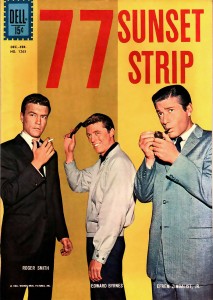 From 1958 through 1964, “77 Sunset Strip” was a television show, which took place at “Dino’s Lodge”, a night spot named for its owner Dean Martin. Located at 8524 Sunset, a plaque commemorates the spot today. One of the most interesting hotels is the Mondrian. Originally a luxury apartment building built in 1959, it was converted to a hotel in 1996 by Ian Schrager with interiors by French designer Philippe Starck. The hotel was originally painted in a brilliant color scheme by Israeli artist Yaacov Agam based on the art of Piet Mondrian, but local uproar over-ruled, and today the building is a restrained white. Still, the interior is a symphony of white tones and non-traditional fabrics and textures. The hotel’s “SkyBar” a well-known gathering place for celebrities is known for it’s fabulous post-Oscar parties.
From 1958 through 1964, “77 Sunset Strip” was a television show, which took place at “Dino’s Lodge”, a night spot named for its owner Dean Martin. Located at 8524 Sunset, a plaque commemorates the spot today. One of the most interesting hotels is the Mondrian. Originally a luxury apartment building built in 1959, it was converted to a hotel in 1996 by Ian Schrager with interiors by French designer Philippe Starck. The hotel was originally painted in a brilliant color scheme by Israeli artist Yaacov Agam based on the art of Piet Mondrian, but local uproar over-ruled, and today the building is a restrained white. Still, the interior is a symphony of white tones and non-traditional fabrics and textures. The hotel’s “SkyBar” a well-known gathering place for celebrities is known for it’s fabulous post-Oscar parties.
“The Whisky”, known back in the 1960s as “The Whisky A-Go-Go” at 8901 Sunset, once featured an unknown house band called “The Doors”, headed by a man named Jim Morrison. Other bands who got their start there were The Kinks, The Byrds, and Led Zeppelin. Jimi Hendrix, The Beatles, Martha and the Vandellas and The Who were also seen there. The birthplace of “go-go dancers”, the club remains popular to this day. The legendary jazz musician Wes Montgomery performed in clubs on the Sunset Strip in the 50s and 60s and even composed an instrumental piece for guitar and orchestra called “Bumpin’ on Sunset” in reference to the limos and elegant automobiles cruising the street.

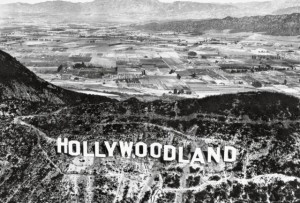
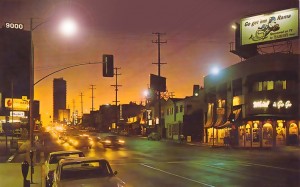
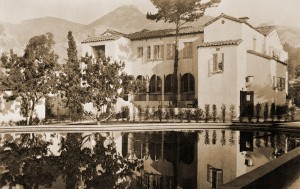
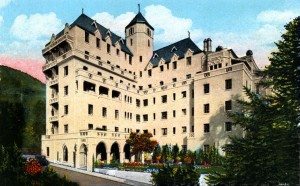

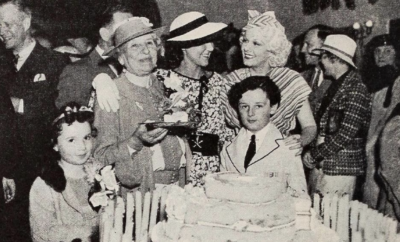
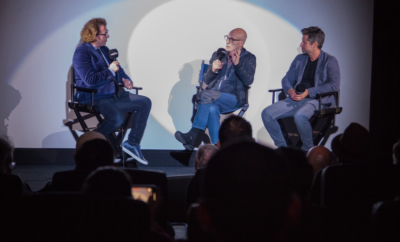
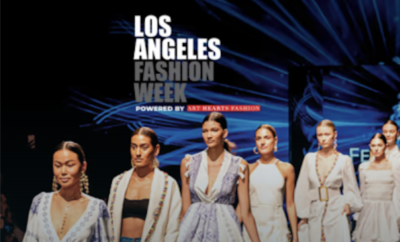
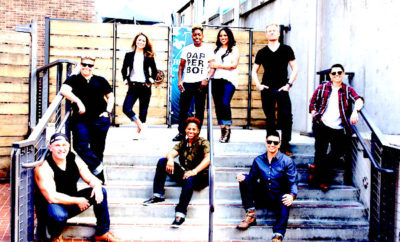

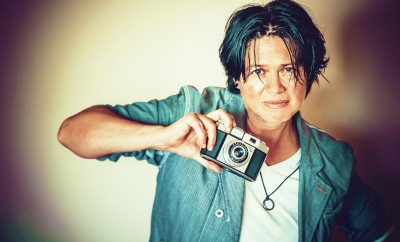
2 Comments
You must be logged in to post a comment Login